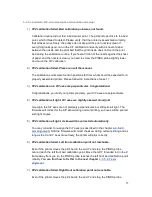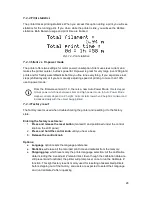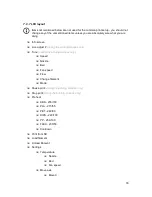
Place a sheet of a regular office paper (for example the checklist
shipped with every order) and hold it under the nozzle during the first
round (first 4 points being checked) of calibration. If the nozzle catches
on the paper during the process, power off the printer and lower the
P.I.N.D.A. probe slightly. See the P.I.N.D.A. probe response diagram in
6.3.10.2 Check probe height
. The paper will not affect the calibration
process. The nozzle must not touch the print surface or deflect the bed
by any means. If everything went correctly, continue with the calibration
process.
Initiating this routine performs a series of measurements in three rounds: In the first round, 4
sensor points on the print bed are searched for carefully so as not to touch the print bed by
the nozzle. In the second round, all 9 sensor points are found. In the last round the height
above the 9 sensor points is measured and stored into a non-volatile memory for reference,
this finished the Z axis calibration.
The progress and results of each step are displayed on the LCD. In case of errors found, the
XYZ calibration is interrupted and the reason for error is shown to guide in troubleshooting.
At the start of the XYZ calibration procedure the printer prompts you by a following message:
"Calibrating X/Y. Move Z carriage up to the end stoppers. Click when done.”
After that, the printer asks you to confirm this step:
"Are left and right Z carriages all up?"
Please make sure you really move the Z carriage up to the end stoppers until you hear a
rattling sound as the Z stepper motors skip steps. This procedure ensures, that 1) the X axis
is perfectly horizontal, 2) the print nozzle is in a known distance from the print bed. In case
the Z carriage did
not
touch the end stoppers, the printer could not possibly know the height
of the print nozzle above the print bed and it could, therefore, crash into the print bed during
the first round of the X/Y calibration procedure.
The XYZ calibration procedure also prompts you to
"Please clean the nozzle for
calibration. Click when done."
If this advice is not followed and there is a plastic debris on the print nozzle, then the debris
may touch the print bed or even push the print bed away from the PINDA probe, so the
PINDA probe will not trigger properly and the calibration will fail.
After the calibration is passed, the values can be reviewed for tweaking later. When you get
your axes
perpendicular
or
slightly skewed
, nothing needs to be tweaked as printer will
perform with the best accuracy. Learn more in chapter
8.3 View XYZ calibration details
(Optional)
under
8 Advanced calibration
.
16
Summary of Contents for Original Prusa i3 MK2S 1.75mm
Page 1: ......
Page 25: ...Pict 11 Probe response diagram Now you are done 25 ...
Page 61: ...Pict 35 Nozzle change 61 ...
















































